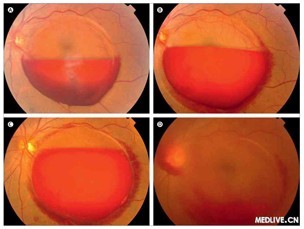|

A和B 黃斑前內(nèi)界膜下出血����。C 隨訪期間血液沉積增加����。D 14天后沉積的血液突破內(nèi)界膜進(jìn)入玻璃體凝膠��。
Sub-inner limiting membrane haemorrhages
The Lancet, Early Online Publication, 15 March 2013
煙臺(tái)毓璜頂醫(yī)院 高磊,東長(zhǎng)霞
2005年7月����,一名47歲的男子因視力下降前來(lái)就診。眼底鏡檢查顯示��,黃斑前內(nèi)界膜下出血(圖A)和內(nèi)界膜的反光�。隨訪中血液沉積逐漸增多(圖B圖C),并在14天后突破內(nèi)界膜進(jìn)入玻璃體凝膠(圖D)��。由于玻璃體出血稠密并且患者視物云霧感一直未消退�,6周后行玻璃體切割術(shù)。術(shù)后視力改善����。初步診斷Valsalva視網(wǎng)膜病變。內(nèi)界膜下出血表現(xiàn)出后極部邊界清晰�、穹窿狀出血,并導(dǎo)致嚴(yán)重的視力障礙�����。常與Valsalva 視網(wǎng)膜病變和Terson綜合征有關(guān)�。
In July, 2005, a 47-year-old man presented to us with impaired vision of his left eye. Fundoscopy examination showed premacular sub-inner limiting membrane haemorrhages (figure A) and a glistening light reflex reflected from the inner-limiting membrane overlying the haemorrhage. The sedimented blood increased during the follow-up period (figure B, C) and eventually broke through the inner-limiting membrane into the vitreous gel 14 days later (figure D). A vitrectomy was done because of the dense vitreous haemorrhage and his complaints of cloudy vision without spontaneous resolution after 6 weeks. Postoperative vision improved. A tentative diagnosis of Valsalva retinopathy was made. Sub-inner limiting membrane haemorrhages appear as sharply demarcated, dome-shaped haemorrhages at the posterior pole and consequently lead to severe visual impairment. They have been reported in association with Valsalva retinopathy and Terson's syndrome.
|